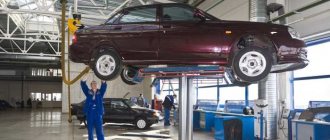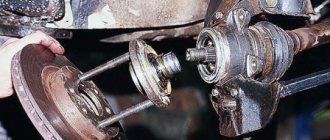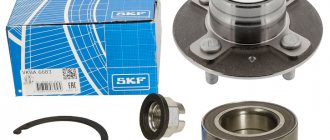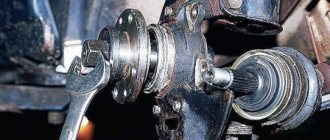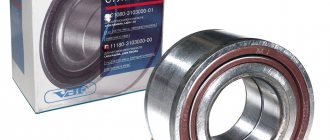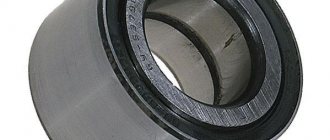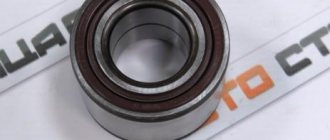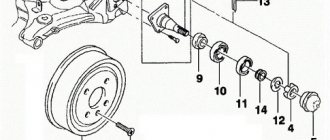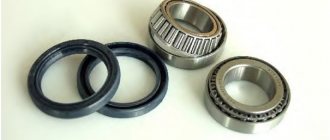The rear wheel bearing for the Lada Granta is a very important element. It is important because it ensures proper rotation of the wheel. As a result of its operation, the bearing experiences significant loads, which is why wear-resistant materials are used in its manufacture. However, no matter how durable materials are used, over time the part fails. Due to the high importance of the unit, its replacement is mandatory as soon as the first signs of malfunction appear.
Bearings Lada Granta
This inexpensive but relatively comfortable car produced by AvtoVAZ OJSC, according to the developers, will soon become a favorite of Russian car enthusiasts, since it combines such qualities as comfort, reliability, safety and, most importantly, a low price for its class.
As in other VAZ models, domestically produced bearings are installed here. This material covers the nomenclature of these products used in cars, as well as their imported analogues (do not forget that Chinese bearing manufacturers, and, for example, the Vologda Bearing Plant (VBF), which is among For some reason, motorists are considered the standard of quality, although VAZ mainly uses bearings from the European Bearing Corporation (Volzhsky and Saratov Bearing Plants)).
List of bearings used in the Lada Granta car that can be easily replaced
To view information on a specific bearing, simply click on the number.
| Knot | Bearing number | Quantity | Imported analogue |
| Differential box (right and left supports) | 7207 | 2 | 30207 |
| Front wheel bearing | 256707 | 2 | — |
| Gearbox shaft bearing (rear support) | 180305 | 2 | 6305 2RS |
| Gearbox secondary shaft bearing | 464706 | 5 | K32x37x27 |
| Clutch release | 520806 | 1 | — |
| Rear wheel bearing | 256706 (ball - higher rotation speed) 537906 (roller - higher load capacity) | 2 | — |
| Transmission input shaft (front support) | 42205 | NJ205 | |
| Transmission output shaft (front support) | 42305 | NJ305 |
It should be noted that in the vehicle documentation, bearing numbers are often indicated with a lot of additional (and often long-outdated) letter designations, which you can ignore. The same applies to accuracy class 6. Nowadays, quality standards are implemented in such a way that bearings with a declared class 6 from one manufacturer can be an order of magnitude worse than the zero class of another.
Source
Lada Granta vLada granta › Logbook › Wheel bearings
I am already observing the third generation of hub assemblies: the first is tapered bearings (roller), two per hub, with an oil seal (s), lubricant and gap adjustment (although there are designs with guaranteed interference when stacked spacer washers are inserted between the inner races).
The second generation is double-row ball (roller) bearings with guaranteed interference (with unregulated clearance, tightened with a large torque). The third generation - non-separable bearing units. On Russian roads (potholes and potholes), it is preferable to use roller bearings, which provide greater resistance to shock loads due to the linear contact patch (roller - cage). Today I changed the rear wheel bearing on a Renault Megane - 2 (the same on Logan) - a roller bearing, second generation (ran 150 tkm). For VAZ PP, at the Vologda Gas Processing Plant (if I’m not mistaken) at one time they produced such (roller) bearings, but they did something wrong - backlash developed during operation. Impacts are contraindicated for ball bearings. Under any shock load (potholes, curbs, accidents, blows to the hub with a heavy hammer when replacing a brake disc and knocking out a stuck CV joint from the hub), pinpoint punctures (scratches) occur on the mirror surface of the treadmill, which then roll out into shells (pitting), when Rolling the balls over the shells creates a vibration with noise, which is sharply transmitted to the body. Ball bearings are more technologically advanced and have lower rolling friction losses compared to roller bearings. The fact that they are not suitable for bad roads does not concern foreign manufacturers. We will have to put up with this in the future. Therefore, it is necessary to protect the hub bearings from shock loads and flooding with water (this includes tire pressure and non-standard wheels and the speed of movement in pits and puddles with fords and hard shock absorbers and repair manipulations). Also, you need to change the bearings only when they become unusable - to protect your loved ones (most likely you will no longer come across bearings of the same quality). No paired or prophylactic replacements. Many car enthusiasts noticed that previously, on old cars, bearings lasted almost forever. Yes, this is a fact, I think there are several reasons - firstly, in my opinion, modern cars have much more stringent wheel rolling conditions - hard rolling radial tires, reducing the height of the tire profile, increasing the diameter of the wheels, increasing the width of the wheels, rigid suspensions (gas-filled struts with a ratio forces 1/1), ABS vibration. Secondly, spare parts (I think that the “original” bearings are now no worse than before), but what’s in the spare parts is a dark forest. A very murky topic, I know for sure that the inscriptions “made there” can quite legally appear on parts made in China for pennies. The main thing is that the legal address (office) of the manufacturer is located in the desired country. Replacing double-row bearings with guaranteed interference is a responsible undertaking. For VAZ - 2108 -18 I have a screw puller, I change the bearing on the spot (without disturbing the camber angles). For larger bearings, pressing the bearing out of the knuckle with a screw puller is a dubious thing, because the friction of the interference fit exceeds the capabilities of the puller thread (a 20-ton hydraulic press is needed). In addition, for each fist, its own equipment is necessary due to the different shape of the supporting surface (not only the diameter) ... In order not to harm the car, when replacing a bearing of this type, you must strictly follow the rules: - If the bearing is changed on a car, then the hub from The inner race can be pressed out with a puller or a reverse hammer, and the outer race can be pressed out of the fist and pressed in only with a puller. — From a knuckle removed from a car, you can press out the outer race with a press or a puller; the main thing is to have a variety of equipment that prevents damage and deformation of the knuckle. - When pressing the outer race into the fist, ensure that the pressure of the press or puller is applied only to the end of the ring of the outer race (no pressure on the inner race is allowed) - for this you need to use dies with recesses on the inside (I always use the race of the old bearing) - When pressing the hub into the pack of internal races of the bearing, the emphasis on the back side of the bearing should be placed only on the inner race (during the entire pressing process, free rotation in the bearing must be ensured) - Tighten the hub nut with the torque recommended by the manufacturer. The seals of a double row bearing must not be opened. Do not add lubricant under the boot (at high rolling speeds of the balls, excess lubricant will be squeezed out and break the seal of the boots). You cannot disassemble a double-row bearing (remove the inner races from it). I began to notice that more and more often double-row bearings of modern budget cars began to fail due to water penetrating inside them... I think this is because modern automakers do not bother at all with the complexity of bearing seals (previously there were water-repellent “labyrinths”, like on the VAZ PP, and now the bearing seal is freely allowed for splashes from under the wheels)… In addition, high-pressure car washers have become widespread (you shouldn’t get carried away with washing wheels and chassis with such intense water pressure that a high-pressure washer produces)… And there is also an idea that Manufacturers who have calculated the seal capacity of modern bearings have calculated it for the properties of ordinary water. And water with detergents or with our road reagents has much greater penetrating power than plain water. This is why wheel bearings have such a short lifespan in our conditions today. Checking the hub bearing for noise Wheel bearings are checked for noise in a room where it is relatively quiet. Each of the four wheels (or the entire car on a lift) is sequentially suspended from the gearbox in neutral gear. Stand on the side of the center of the wheel. Grab the wheel with your right hand (carefully so that your fingers do not get under the caliper or rub against anything when turning the wheel with your hand). You can rotate the wheel on the bearing with your right hand half a turn to the right or left, you can spin the wheel many turns with acceleration clockwise, for example. The free hand (left) should rest on one of the suspension parts (on the strut, strut spring, lever...). ———————— If there is noise in the bearing, then “hard rolling of the bearing” will be observed. This will be felt by your left hand in the form of vibration on the suspension parts. This will be audibly felt in the form of low-frequency noise (the rustle of the pads, the noise of the satellites in the gearbox do not count). The sensation of vibration is as if you put a small bearing on your finger and rolled it over a smooth oiled sheet of metal (no vibration), and then rolled it over a large rasp (there is vibration). ————————- A slight play in the hub (without noise) is not a sign of a defective bearing, although wear on treadmills is often accompanied by play. About the fact that if the noise intensifies when turning left, change the right wheel hub bearing. Many drivers have experienced noise and vibration while driving from the hard rolling of faulty wheel bearings. There is an opinion that by the nature of changes in this noise when cornering, you can find out on which side of the car the wheel with a faulty wheel bearing is located. It is believed that increased hub bearing noise when turning a corner indicates that the bearing of one of the wheels moving along the outer radius of the turn is humming. It is also believed that when a wheel moves along the inner turning radius, the noise of a faulty bearing in the hub of that wheel should subside. In practice, this rule does not always work. Most modern cars have double-row ball (or roller) bearings in their wheel hubs. The wheel of a car moving around a turn perceives a weak lateral reaction from the road, applied in the contact patch of the wheel with the road. This reaction is directed towards the center of rotation. At the same time, the same magnitude of force acts on the wheel axle from the side of the car, directed from the center of rotation. These two differently directed forces acting on the arm of the wheel's rolling radius create a strong moment that tends to tip the wheel outward from the center of rotation. Similar moments, identical in direction, act on all four wheels of a car moving around a turn. This “tipping” moment acting on the wheel selects play in the double-row wheel bearing and loads the raceways on the outer bearing race differently. The wheel bearings of the right and left sides of the car are loaded when turning in the same way. A malfunction of the wheel bearing, which causes noise with vibration when the car is driven, is caused by the formation of cavities on the raceways of the bearing races. If the shells are located in the upper part of one of the raceways of the outer race of the wheel bearing (this is usually the case), then the increase or decrease in bearing noise during turns will be determined only by the direction of the turn, regardless of whether this wheel is moving along the outer or inner radius of the turn. Therefore, the method of identifying a faulty bearing by changes in noise when cornering should be used only for preliminary diagnostics. original "hodovik-razval"
Replacement and selection of rear wheel bearing Lada Granta
On front-wheel drive cars of the Lada Granta family (Sport, Liftback, Sedan. 2190, 2191), the rear wheel wheel bearings are just as susceptible to wear and periodically fail as the front bearings. As a rule, extraneous noise appears during acceleration - vibration, sometimes grinding.
Replacing the Lada Granta wheel bearing, in turn, is carried out independently, without the use of special tools (press, puller), you only need a stationary vice, as well as a standard set of keys.
This article describes in detail the process of replacing the rear wheel hub bearing, with photos and videos. Also, after the instructions, information is provided on the selection of spare parts, catalog numbers, brand, article, manufacturer and prices (be sure to read this information before buying a rear wheel bearing for Grant).
Replacing the front wheel hub bearing
We replace the bearing when it fails. There are two ways to replace a bearing. The first is by removing the steering knuckle assembly, the second is without removing it from the car. The work is shown on the right wheel bearing. The left wheel hub bearing is replaced in the same way. We carry out the work on an inspection ditch or overpass. We remove the wheel.
Using a screwdriver, remove the protective cap from the hub. We install the wheel and tighten the two bolts that secure it. We lower the car onto its wheels.
Use a beard to straighten the collar of the hub bearing nut, which has been dented in two places. Apply the parking brake, engage first gear and place chocks under the wheels.
Use a 30mm socket to loosen the hub bearing nut. The nut is tightened with a large torque, so the head and driver must be strong enough to transmit the necessary force. We hang up the front part of the car (namely both front wheels, because otherwise the anti-roll bar interferes with dismantling, pushing the suspension elements up). We remove the wheel. Unscrew the hub bearing nut completely...
...and remove the puck. Remove the front wheel brake disc (see “Removing the front wheel brake disc”). Disconnect the right wheel drive from the hub (see “Removing the front wheel drives”). In order not to disturb the wheel alignment angles, you can replace the bearing without removing the steering knuckle. To do this, connect the ball joint to the knuckle...
...and compress the hub by striking it through a soft metal drift. You can also compress the hub using the front wheel brake disc.
We pass M12×1.25 mm bolts about 130 mm long through two diametrically opposite holes in the disk and screw them into the holes of the hub to a depth equal to its thickness. By sharply hitting the bolt heads with a disk, we compress the hub. If it was not possible to remove the hub in this way, remove the steering knuckle. To do this, unscrew the nuts of the bolts securing the shock absorber strut to the steering knuckle, remove the bolts (see “Removing the shock absorber strut and disassembling it”). Disconnect the ball joint and remove the steering knuckle.
How to check the rear wheel bearing of Lada Granta 2190
Before getting acquainted with the technology for diagnosing the rear wheel hub assembly, let’s find out the reasons for the failure of the Lada Granta hub bearing:
- Service life (operation);
- Wear from loads due to aggressive driving style;
- Destruction of the surface of the raceways due to driving over potholes, etc.;
- Drying of the lubricant, heating;
- Moisture and dirt getting inside.
The listed reasons are the main ones; ball bearing failure sometimes occurs due to a malfunction of adjacent components. It is recommended to check the support bearings on the Lada Granta by analogy.
As mentioned above, if you begin to notice extraneous noise from the wheels, as well as possible vibrations, then the bearing assembly of the VAZ 2190 (Granta) must be checked on both sides, for this:
- We lift the car with a jack, hanging the wheel;
- Spin the chassis by hand to verify the source;
- The ease of rotation is also impaired;
- A backlash appears, which is also felt by the hands;
- To accurately determine the type of failure, you will have to disassemble the unit and remove the hub.
- The following are videos that we recommend watching before making a diagnosis.
Signs of a faulty rear wheel bearing on a Grant
In order to replace an element in a timely manner, you need to know the symptoms that indicate its inoperability. Below are some of the most common:
- Vibration during vehicle driving conditions. Vibration can be felt both in the car body and in the steering wheel when driving. If such signs appear, a thorough diagnosis and (or) replacement of the unit is immediately carried out.
- The appearance of a specific hum, crunching noise when moving. Such sounds indicate mechanical damage and destruction of the hub mechanism (spherical elements).
Original articles, catalog numbers
Front wheel hub bearing (No. 6)
:
- 11180-3103020-00 or 8450051118 - “VPK” CJSC Vologda
- 11180-3103020-04 or 8450051120 - “TD EPK” LLC, Moscow
Rear wheel bearing (No. 11)
:
- 21080-3104020-00 or 8450054096 - "VPK" CJSC Vologda
- 21080-3104020-02 or 8450054097 - “TD EPK” LLC, Moscow
- 21080-3104020-04 or 8450054098 - “TD EPK” LLC, Moscow
The price of the original bearing is about 1200 rubles.
Analogs
- AUTO DETAIL
- VPZ
- GPZ
- RUSSIA
- AT
- AUTORAM
- BAUTLER
- BZAK
- GALLANT
- GAMMA
- HOLA
- LGR
- PILENGA
- SS20
- QML
- STARNER
- METACO
- TRIALLI
- STELLOX
- ZOMMER
Determine the best wheel bearing
by voting. Leave feedback in the comments, in which you can indicate:
- Which brand of wheel bearing did you choose and why?
- What was the service life of the factory wheel bearing?
Share on social networks:
Found an error? Select it and press Ctrl+Enter..
Comments
TOP materials of the week
TOP products in the store (more)
Who services your Lada Priora?
Lada.Online
Lada (“Lada”) is a brand of cars produced by JSC AVTOVAZ. Previously, it was used only for export cars, and for the domestic market, cars were produced under the Zhiguli brand. In 2004, the management of AVTOVAZ announced the transition to the Latin alphabet for the official spelling of the names of all cars produced by the plant: Lada - instead of "VAZ" and "Lada".
Lada.Online is the largest Russian-language automotive resource with a daily audience of thousands, which is dedicated primarily to cars of this brand, the domestic automotive industry and the automotive world in general.
This site is not the official LADA website.
© 2022 Lada.Online. Copying of material is permitted only with a link to the source.
Source
Dimensions of wheel bearings for Lada Granta
Bearings Lada Granta (VAZ-2190, 2191)
In the list, numbers are indicated only with significant additional designations (for example, A - reinforced, Ш - noise requirements, etc.), if there are other modifications that are less suitable, the numbers for the VAZ are indicated in full.
Topic: Differences between VAZ 2108 and 2190 Grant. Replacing the rear wheel bearing. Catalog number 2108-3104020 or 256706 There are a lot of manufacturers CRAFT FENOX RTBB12313O7 HOLA NB722 took this TRIALLI CS 256 WEBER BR 2108—4020 VPZ-15 CHINA SPZ-4
To the heap, change the oil with flushing, and small things! candles, filters, lamps. In stock: VAZ 2191 Lada Granta liftback
But her rear lights and bulbs are different. In the first part, a small mistake was made, the rear light bulbs are not dual-mode, but there is one bulb for the stop and one for the marker.
Text without photos because we are watching a video
The rear bearings are the same as 2108 (all front-wheel drive), the hubs are the same, the pads are 1118 2170 with ABS, and we have grants with ABS like this
ABS rotor VAZ 1118-2170 rear wheel 1118-3538400 + ABS sensor
The rear brake cylinder is like a figure eight. There are also small differences in the fastening of the rear wheel hub axle 2108-31104055 (hexagon), as well as in the front suspension; different bolts are used for the balls and for fastening the caliper bracket with an E-12 head, which require a slightly different tool. We disassemble/assemble like a figure eight/nine
The rest is the same, the same “nine” Have a nice weekend! Feel free to visit me in PM aka garage (advice/repair), Blog (personal opinion), Matiz on 16 discs Motya
Other items Cabin filter GB-9831/C Fuel filter GB320 (2123-1117010) fit according to book 2190-1117010
It all started when I noticed a hum at a speed of >130 km/h. Then this hum began to appear at 100 km/h. It ended up that the car began to hum already at 60 km/h.
Wheel bearing Lada Granta
Replacing the Grant rear wheel bearing
To find out what condition the Lada Granta rear wheel bearing is in, you need to hang the wheel in a free state and rotate it by hand. Ideally, the wheel should spin evenly and smoothly without knocking or sticking.
But it happens that the car owner hears extraneous noise while driving, like a buzzing or howling, or when shaking a suspended wheel, he notices a rather significant play. In this case, we can say that the support bearing of the rear wheel hub may fail.
If we talk about the durability and reliability of the bearings of the Lada Granta car, then we must admit that many car owners, when operating their car in the first thousand kilometers, noted failure or breakage of the hub.
Perhaps in the future this error will be corrected by the manufacturers of the Lada Granta, but today we will proceed to the independent step-by-step repair and replacement of the bearing on the rear wheel hub of the Lada Granta car.
In the Lada Granta model, the front hub bearing also requires adjustment and replacement from time to time, but here for now we will talk about the rear hub bearing.
The hub is equipped with a double-row ball bearing, which, it should be noted, requires absolutely no maintenance - no lubrication, no adjustment.
Hub configuration
How to change the rear wheel bearing of a Lada Granta
So, let's get started, below are 14 detailed stages of the work:
- Remove the plastic protective cap from the rear wheel.
- We move the gearbox lever to the “1st gear” position. To prevent the car from rolling away under the front wheels, we place supports.
- We loosen the tightening torque for the hub nut (it is most convenient to use a long lever). Unscrew it a little and loosen the bolts holding the wheel.
- Using a reliable jack, we lift the rear side of the car, where the bearing is actually changed.
- Unscrew the nuts and remove the rear wheel from the studs. We dismantle the brake drum.
- Unscrew and remove the hub nut, take out the thrust washer.
- We take the previously prepared puller in our hands and carefully press the hub from the axle.
- Now we take the hub, install it and clamp it with a vice. Remove the retaining ring (use a puller).
- Press the bearing out of the rear hub. Then, using a brush with metal bristles, we clean the inside of the hub from dirt. We press the new product back in. Don't forget to install the special retaining ring correctly.
- Taking advantage of this opportunity, we clean the brake system elements from rust and contaminants.
- We put the hub back on the axle element. We return the brake drum to its place and put the wheel back on.
- Tighten the wheel bolts. Let go of the raised part of the car until the wheel is firmly in contact with the ground.
- Tighten the hub nut securely using a long-lever wrench (or a special hub wrench). We return the protective plastic cap to its place.
- In order to check the results of the work performed, we start the car engine and start driving.
This completes the replacement of the rear wheel bearing (Lada Granta). As you can see, the process is not too complicated. All you need is a good specialized tool and some free time.
How to replace the rear wheel bearing of a Lada Granta?
Front-wheel drive models of this line require periodic replacement of the rear wheel bearing in the same way as rear-wheel drive cars.
As a rule, their failure is indicated by the appearance of extraneous noise that occurs when the car is moving, grinding and vibration.

